Where are the most impressive (and sometimes hidden) ceilings in Italy? Exploring these masterpieces scattered throughout the country is a unique and thrilling journey through art, history, and architecture. Illusionistic ceiling painting—featuring the challenging "from-below" perspective—was born in the Renaissance with Melozzo da Forlì and flourished through the Baroque and Rococo periods, continuing to influence artists to this day.
In most cases, the result is astonishing: there are countless places so surprising they can enchant, unsettle, and even confuse the most knowledgeable and attentive observers. The ultimate reference point for all painted ceilings in Italy is the Sistine Chapel, home to the world's most beautiful and iconic frescoes: Michelangelo's masterpieces. However, this article will guide you through 10 alternative marvels, far from the usual and ordinary: some well-known and worth revisiting, others lesser-known and full of curiosity and wonder.

Art Above Us: 10 Most Stunning Painted Ceilings in Italy

Sailko, Wikipedia, CC BY-SA 3.0
Ceiling fresco illusionism is a hallmark of Italian art. The "from-below" perspective style—one of the most challenging techniques—has its roots in ancient Roman wall painting, and reappears in 16th-century Venice, where Byzantine foundations mix with late Gothic and Orientalist elements. It was during the Renaissance that perspective illusionism and "from-below" burst into vaults and domes, creating the powerful illusion that the ceiling stretches beyond physical limits.
From North to South, in famous landmarks throughout the peninsula, Italy is rich in works of this kind that inspire awe and invite detailed observation. What makes Italian painted ceilings so special and unique is the style and personality of the artists who created them. At every stop (except one, which is not always accessible to the public), visitors can take photos and enjoy guided tours that focus on architectural details. Are you ready to be amazed?
10. Church of St. Ignatius of Loyola, Rome
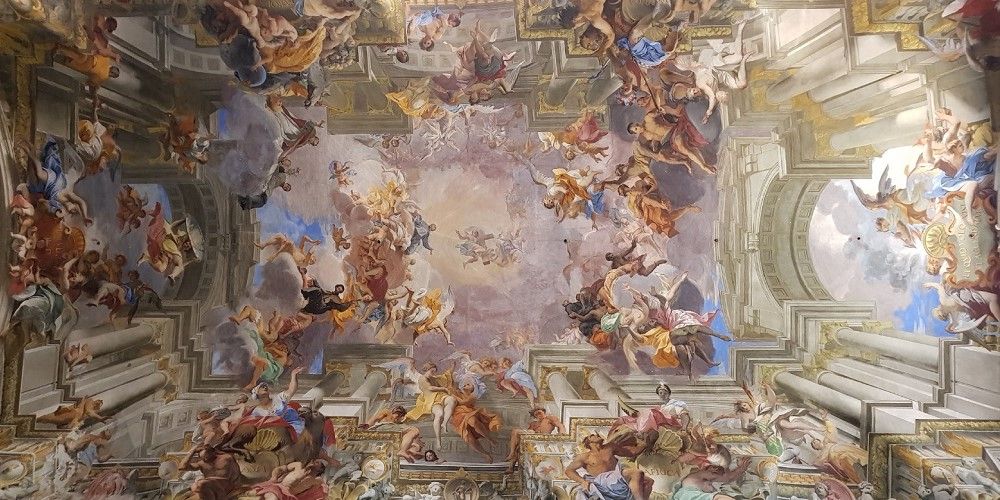
Compagnia di Gesù
Campo Marzio is one of the oldest and most atmospheric districts in Rome. Here stands the baroque church built in 1626 in memory of Ignatius of Loyola, founder of the Jesuit order. Bishop Ludovico Ludovisi, nephew of Pope Gregory XV, commissioned the ceiling and fake dome from Jesuit painter, architect, and mathematician Andrea Pozzo, a master of illusion and perspective theory. The result is astonishing. The large frescoed dome near the altar is a three-dimensional optical illusion: in reality, it is a painting on canvas that gives the impression of standing beneath an actual dome. There is even a "special" mirror that allows visitors to see themselves with the painting behind them.
The main ceiling fresco, The Glory of Saint Ignatius, presents the second incredible optical illusion. Visitors standing on a yellow marble disc in the center of the nave experience the sensation that the image breaks through the ceiling, making the roof seem infinite. Blue sky, clouds, and architectural elements like columns and arches give the illusion of another church hovering above the real one. Pozzo's goal was to portray Saint Ignatius carried by angels, bringing God's grace beyond the limits of the world. At the short ends of the ceiling is a verse from the Gospel of Luke that inspired the work: "I came to bring fire to the earth, and how I wish it were already kindled!"
9. San Pantalon, Venice
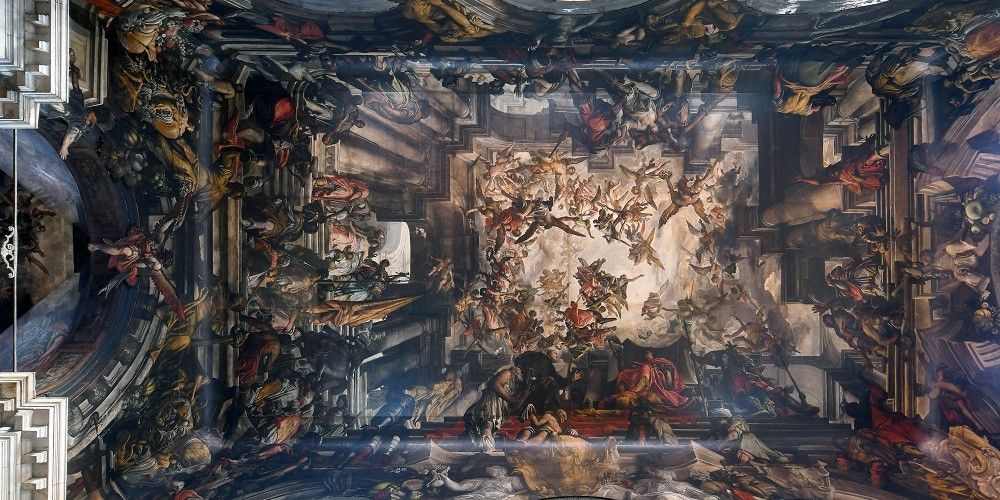
Architas, Wikipedia, CC BY-SA 4.0
Saint Pantaleon of Nicomedia (in modern-day Turkey) is one of Christianity's most venerated martyrs. His cult is ancient, dating back to his death in 305 AD during Diocletian's persecutions. In Venice's Dorsoduro district stands the church built in 1704 by Francesco Comin. Instead of a fresco, the ceiling features a massive oil painting on canvas, known as a telero, mounted on a wooden frame to simulate a fresco. Martyrdom and Glory of Saint Pantaleon is composed of 44 canvases covering 443 square meters, making it the largest work of its kind in the world.
Created by Venetian painter Giovanni Antonio Fumiani over 24 years (1680–1704), the piece draws on his theatrical scene painting skills, merging real and imaginary architecture with dramatic perspective. The central image shows Pantaleon welcomed into heaven by Jesus and surrounded by angels. Below are the twelve apostles, and in the corners, the cardinal and theological virtues. On the right is a judgment scene; on the left, the executioners. Themes of pride, fury, justice, and peace complete the composition. Fumiani, Paolo Veronese, Jacopo Palma the Younger, and Gregorio Lazzarini contributed to six other canvases in the chapel.
Discover all Venice with the Visit Venice Pass8. Castle of Sammezzano, Leccio (Reggello)
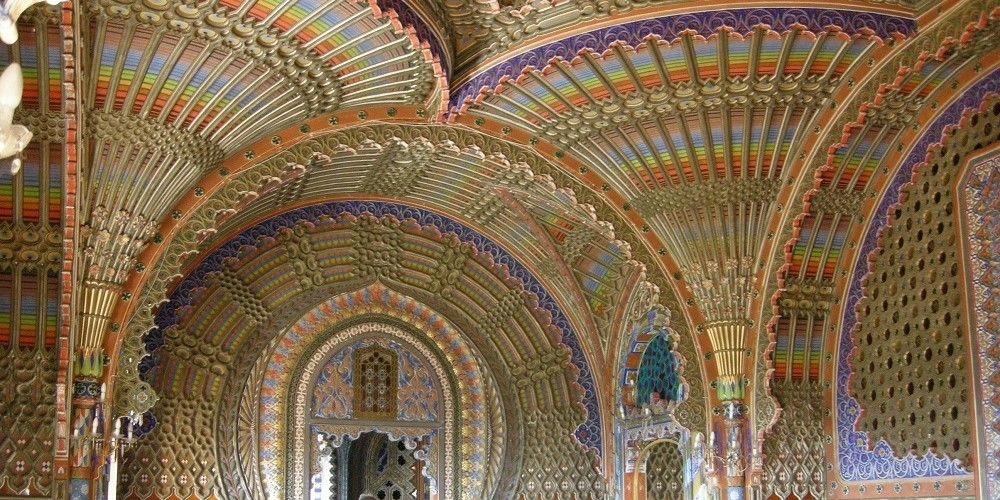
Sailko, Wikipedia, CC BY-SA 3.0
Just outside Florence in the town of Reggello, Castle of Sammezzano is a rare architectural wonder with a 65-hectare park. It changed hands many times over the centuries until the mid-1800s, when Ferdinando Panciatichi Ximenes d'Aragona redesigned it in full trompe-l'oeil style. The result is the only example of Orientalist architecture in Italy, featuring the Hall of Columns, the Peacock Room, and the Lily Room—all decorated with dazzling mosaics, multicolored stucco, domes, bas-reliefs, and ornate ceilings.
The work, carried out from 1843 to 1889, merges Indian mandala designs with Andalusian Arab art. Over the years, the castle became a set for several films, including Pasolini's Arabian Nights and Garrone's Tale of Tales. After decades of neglect following the death of Marianna, Ximenes d'Aragona's heir, the castle was auctioned in 1999 and partially restored. In May 2025, the Moretti family of Florence purchased it for 18 million euros. It is now being restored for public opening.
7. Florence Cathedral
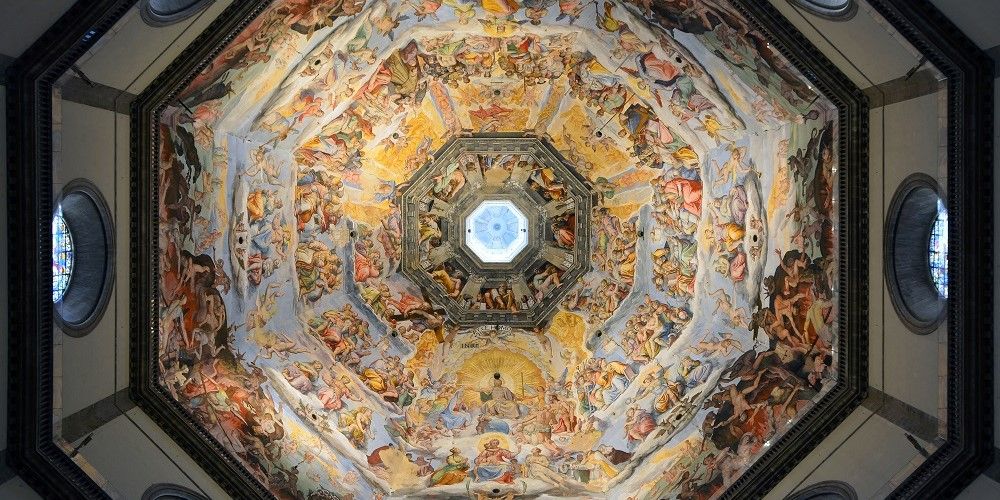
Santa Maria del Fiore is Florence's iconic cathedral. Its fame is due to Brunelleschi's dome, the debated facade by Arnolfo di Cambio (finished by Emilio De Fabris), and the massive Last Judgment fresco by Giorgio Vasari and Federico Zuccari. Started in 1572 and completed in 1579, it is the world's largest wall painting, covering over 3,600 square meters with more than 700 figures. Viewers can easily get lost in this sea of 248 angels, 235 saints, 102 religious figures, 35 damned, 23 putti, 21 personifications, 14 demons, 13 portraits and 12 animals.
In this infinity of allegories, the sense of reading is both vertical in order of the segments and horizontal according to the overlapping concentric registers. The frescoes transition from Vasari's Florentine style to Zuccari's Roman influence, switched from traditional fresco to wall tempera, from Michelangelesque grandeur to Raphael-inspired emotion. Surviving to this day despite the fact that at the time of the inauguration not everyone was satisfied with the final result, the frescoes underwent extensive restoration between 1980 and 1995. The spectacular pictorial cycle that decorates the dome's immense intrados has transformed it to all intents and purposes into the "Florence's Sistine Chapel."
Visit Florence Cathedral6. Parma Cathedral
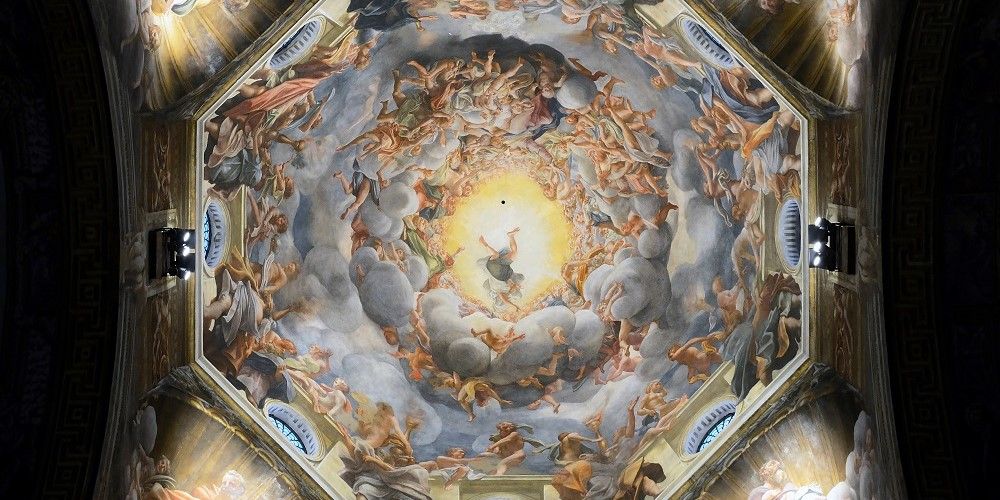
Livioandronico2013, , Wikipedia, CC BY-SA 4.0
Consecrated in 1106 and completed in 1178, the Romanesque church of Santa Maria Assunta is a special place of art, history, and spirituality. At the heart of the ducal city, the cathedral houses three grand ceiling frescoes by one of the most important Renaissance painters: Antonio Allegri, known as Correggio. The most astonishing and extraordinary is The Assumption of the Virgin, a marvelous work of perspective and a masterpiece of visual illusion that decorates the octagonal dome of the basilica. Completed in 1530 and deemed scandalous by some critics, the work merges Renaissance style with Baroque art. Saint Bernard of Clairvaux, Saint John the Baptist, Saint Joseph, and Saint Hilary—the four patron saints of Parma—stand prominently in fake shell niches within the pendentives. The apostles appear in the foreground on a trompe-l'œil balustrade, painted above a fake frame.
On the western side of the dome, rather than in the center, the viewer standing at the foot of the stairs leading from the central nave to the altar is struck by the vision of Mary ascending to heaven: from a great and dazzling yellow light, Christ descends to welcome the Virgin, accompanied by a swirling intertwining of angels, cherubs, and biblical figures. The patriarchs, led by Adam, are to the Virgin's right, while Eve leads the female figures to her left. Correggio's Paradise is an explosion of joy, a triumph of song and sound: an absolutely innovative concept, still awe-inspiring 500 years later.
5. Camera degli Sposi, Castello di San Giorgio, Mantua
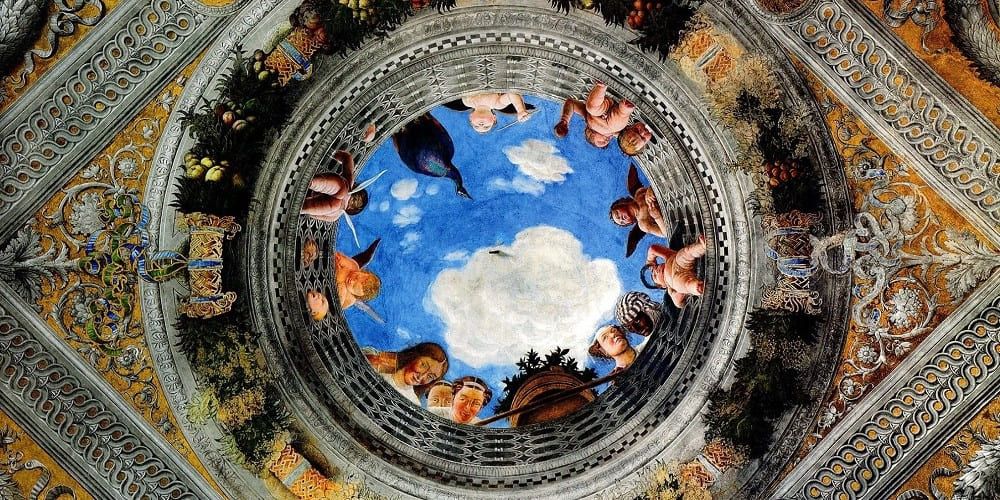
Wikimedia Commons, CC BY-SA 4.0
Originally the official residence of the Bonacolsi family, the Ducal Palace is best known as the seat of the Gonzagas, the dukes of Mantua. In the northeast tower of the castle, part of the palace and one of the city's most iconic monuments, lies the so-called Camera picta, as it was referred to in ancient chronicles: a room for audiences and representation, celebrating the political and social achievements of Ludovico III's family on the occasion of his son Francesco's elevation to cardinal. The decoration of the walls was entrusted to court painter Andrea Mantegna, who between 1465 and 1474 completed a work that entered art history in its own right.
What made the room world-famous and admired is the innovative ceiling fresco that creates the effect of a false vault and the illusion of depth, with a stunning oculus at its center that pushes beyond the limits of Mantegna's earlier experiments in the Ovetari Chapel in Padua. Framed by garlands of fruit and foliage, the oculus opens to the sky and gathers around a balustrade various characters: several putti (some dangerously teetering at the edge, enhancing the perspectival effect), a court lady with her Black maid, three housemaids, a potted plant, and an exotic peacock. A dizzying vision, restored in 1987 and absolutely unmissable.
4. Cappella Sansevero, Naples
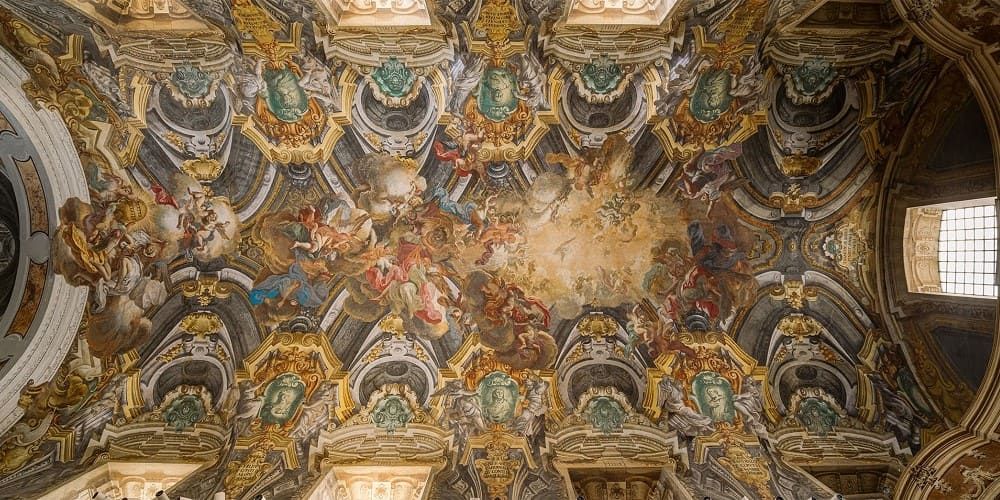
Museo Cappella Sansevero
Tourists crowding Naples often make a mandatory stop at the cathedral to visit the chapel of the Treasure of Saint Januarius with its cycle of Baroque frescoes painted on the vaults and dome by Domenichino and Giovanni Lanfranco. Less frequented by hit-and-run tourism but no less evocative is the barrel vault of the Cappella Sansevero, completely frescoed by Francesco Maria Russo in 1749. The Baroque masterpiece covering the entire ceiling is known as Glory of Paradise or Paradise of the di Sangro, named after the Prince of Sansevero, Raimondo di Sangro—a brilliant esotericist, scholar of military art, inventor, and experimenter of the so-called oloidric painting (a secret mixture that allows fresco colors to resist atmospheric agents) who commissioned nearly all the sculptures and paintings within the chapel.
The spatial effects, three-dimensional illusion, vivid and intense colors, and bursts of light are the defining features of the fresco, along with the powerful symbolism in its central element: the dove of the Holy Spirit, crowned with a triangular halo (a symbol of the Trinity, but also of cosmic birth and light in Masonic iconography) and surrounded by angels. Between the windows, six medallions with portraits of saints from the di Sangro family catch the viewer's eye. In the heart of Naples' historic center, off traditional tourist routes, the Pietatella (as the church is known, from Santa Maria della Pietà) houses this extraordinary vault which, thanks to oloidric painting, continues to amaze nearly three centuries after its creation.
Discover all Naples with the Naples Pass3. Clementine Hall, Vatican City
The Apostolic Palace designed by Bramante is the imposing Vatican building where the Pope appears every Sunday for the traditional Angelus. A historic and solemn papal residence, it includes numerous apostolic chapels (the most famous being the Sistine, Pauline, Niccoline, Redemptoris Mater, and Urban VIII's chapel), ancient apartments and papal courtyards, and above all, the famous halls: the Sala Regia, the Sala Ducale, the Vatican loggias, and various state rooms for audiences. The largest and most fascinating is the Clementine Hall, built around 1598 by Pope Clement VIII of the Aldobrandini family, who dedicated it to Clement I, the third pope in history.
The entire Clementine Hall, on the palace's second floor, is covered with extraordinary Renaissance frescoes, but standing out on the ceiling is the Apotheosis of Saint Clement by Giovanni Alberti from Borgo San Sepolcro, who worked with his brother Cherubino and colleague Baldassare Croce on the ceiling and wall decorations. The martyrdom, ascension to heaven, and spiritual legacy of Clement—one of Christianity's most mysterious and intriguing figures—dominate the vault. One element of the work regained relevance in 2025: the depiction of the crossed keys of the Pope, emblem of Saint Peter's authority, and the two angels holding the umbraculum, the papal umbrella symbolizing the Catholic Church.
This image was used as the design for four Vatican stamps issued during the Sede vacante of 2025, the period between the death of Pope Francis and the election of his successor, the American Cardinal Robert Francis Prevost, who became Pope Leo XIV. The choice was no coincidence: the body of the Pope is traditionally displayed in the Clementine Hall after his death. Today, the room is inaccessible to the public and is not part of the Vatican Museums' visitor route; it is opened only for special occasions such as formal events, cardinal meetings, state leader visits, and private ceremonies during papal funerals.
Visit the Vatican Museums2. Pantheon, Rome
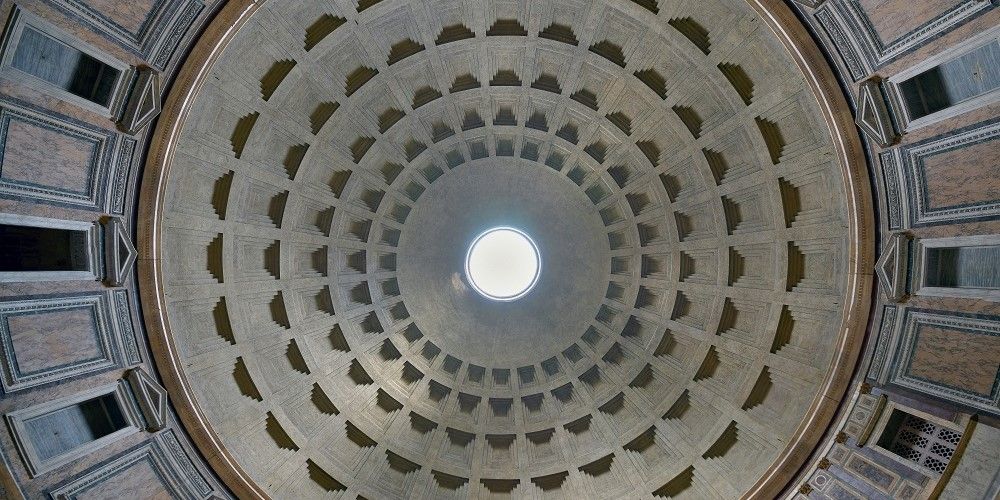
Architas, Wikipedia, CC BY-SA 4.0
Founded in 27 BCE by Marcus Vipsanius Agrippa and built as a temple dedicated to all past, present, and future deities, the Pantheon was reconstructed under Emperor Hadrian and transformed into a Christian basilica by Pope Boniface IV, becoming Santa Maria ad Martyres. Though it does not have a proper painted ceiling, its concrete dome holds the record as the largest in the world (larger in diameter than those of St. Peter's Basilica, Florence Cathedral, and Hagia Sophia in Istanbul), and its interior, once entered, leaves visitors in awe. The decoration consists of five rows of 28 diminishing coffers (28 being a perfect number, the sum of 1 + 2 + 3 + 4 + 5 + 6 + 7), interrupted by a central oculus nearly 9 meters in diameter that allows natural light to enter.
Due to this oculus, the Pantheon lets in rain: drops fall through the opening, but the concave floor, sloped edges, and 22 drains are ingeniously designed to prevent puddles. What truly captures the eye is the architecture of the dome itself, built entirely of concrete with no internal support framework. Credit goes to Hadrian, who advised his architects to lighten the structure as it rose by thinning the walls and mixing lighter materials like travertine and pumice into the concrete. "It is the most beautiful remnant of Roman antiquity: a temple that has suffered so little it appears as it must have to the Romans of its day," wrote French author Stendhal during his 19th-century visit.
1. Palazzo Farnese, Rome
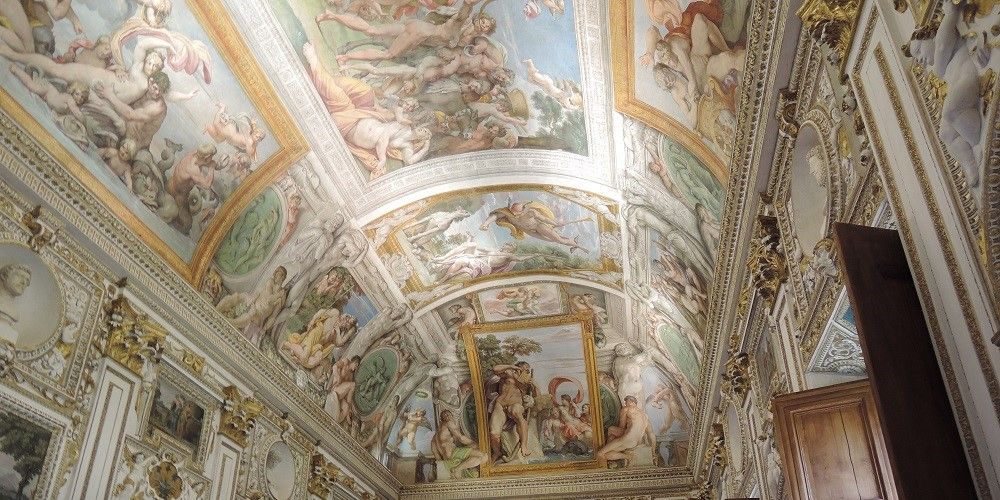
Andrea Gennari, Wikipedia, CC BY 2.0
In 1594, Cardinal Odoardo Farnese invited Annibale Carracci, one of the most prominent painters of the time, from Bologna to Rome to decorate the gallery of Palazzo Farnese, long considered one of the four wonders of the city. Between 1597 and 1608, Annibale, aided by his brother Agostino and students including Domenichino, painted a 20-meter ceiling with mythological subjects inspired by the loves of the Gods and scenes from Ovid's Metamorphoses. In the central section are the triumph of Bacchus and Ariadne with Pan and Diana on the left and Mercury and Paris on the right. Above are Hercules and Iole, Aurora and Cephalus, and Venus and Anchises; below are Jupiter and Juno, a marine triumph, and Diana and Endymion; to the right Polyphemus and Galatea and Apollo and Hyacinth; to the left Polyphemus and Acis and the abduction of Ganymede; in the medallions are Hero and Leander, Pan and Syrinx, Hermaphroditus and Salmacis, Omnia vincit Amor, Apollo and Marsyas, Boreas and Orithyia, Orpheus and Eurydice, and the abduction of Europa.
The Farnese ceiling is a Renaissance masterpiece: sculpture, painting, and architecture intertwine; architectural elements alternate with framed scenes; and the frescoes offer unique optical and perspective effects to tell stories of love and the interplay between spiritual and carnal realms. The work was completed in 1608, and less than a year later, on July 15, 1609, Annibale Carracci died at just 49 years old, likely suffering from deep depression, perhaps due to his patron's lack of appreciation. Yet the Bolognese painter's work remains unparalleled: a realist among Mannerists, his study of nature anticipated the birth of the Baroque in Italy.
About the author
Written on 14/05/2025


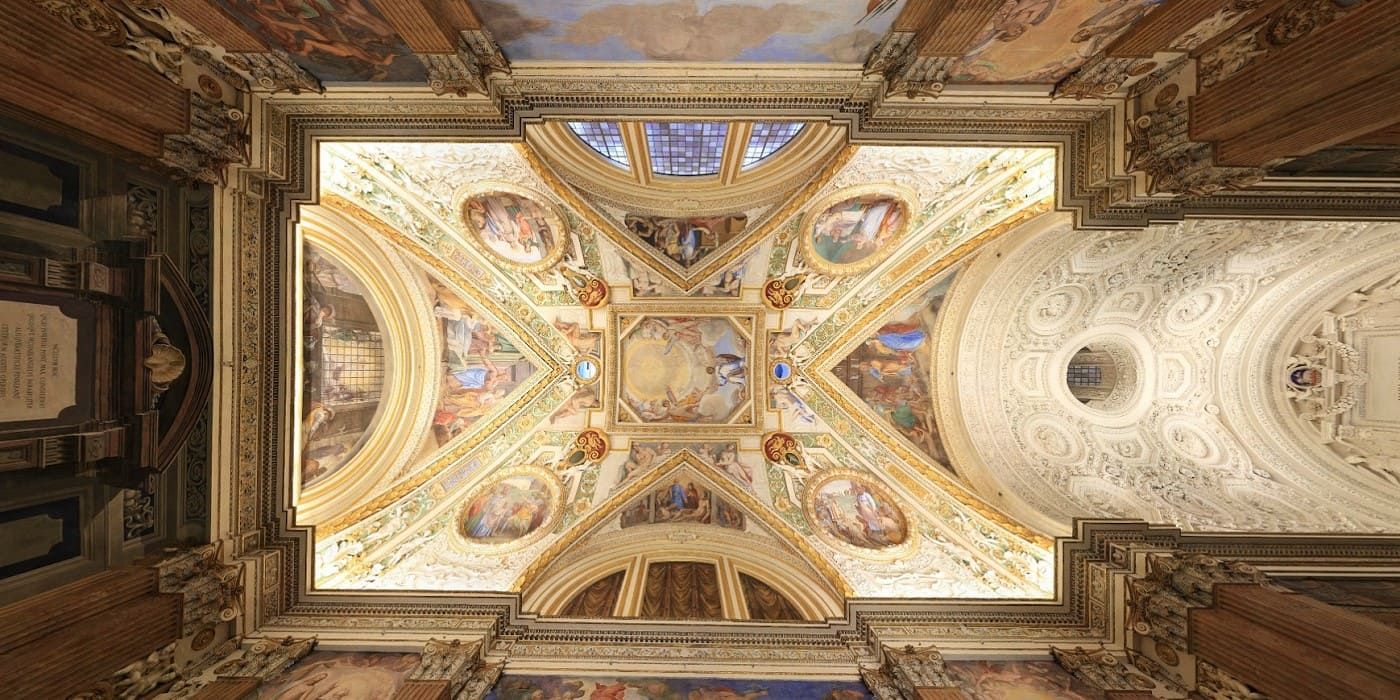

Alessandro Zoppo
Discover 10 incredible frescoed ceilings in Italy beyond the Sistine Chapel: a journey through surprising trompe-l'oeil effects.